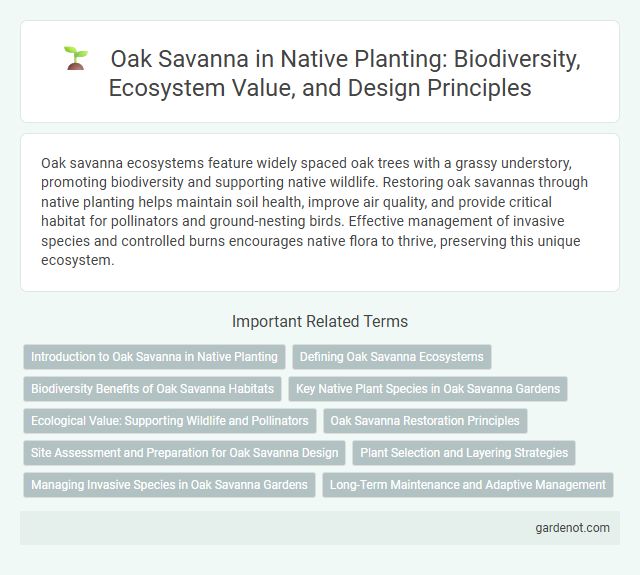Oak savanna ecosystems feature widely spaced oak trees with a grassy understory, promoting biodiversity and supporting native wildlife. Restoring oak savannas through native planting helps maintain soil health, improve air quality, and provide critical habitat for pollinators and ground-nesting birds. Effective management of invasive species and controlled burns encourages native flora to thrive, preserving this unique ecosystem.
Introduction to Oak Savanna in Native Planting
Oak savanna is a unique native planting ecosystem characterized by an open canopy of oak trees with a diverse understory of grasses and wildflowers. This habitat supports high biodiversity, including numerous native plant species adapted to periodic fire and well-drained soils. Restoration of oak savanna promotes ecological balance, enhances wildlife habitat, and preserves important native plant communities.
Defining Oak Savanna Ecosystems
Oak savanna ecosystems are characterized by a sparse canopy of native oak species such as Quercus alba or Quercus macrocarpa, interspersed with diverse grasses and wildflowers adapted to periodic fire regimes. These ecosystems support high biodiversity by providing habitat for specialized plants and wildlife reliant on open, sunny conditions and nutrient-rich soils. Maintaining natural fire cycles and controlling invasive species are critical for preserving the structure and function of oak savannas.
Biodiversity Benefits of Oak Savanna Habitats
Oak savanna habitats support exceptional biodiversity by providing a unique blend of open canopy and grassy understory, which fosters diverse plant and animal species. These ecosystems serve as critical refuges for native wildflowers, pollinators such as native bees and butterflies, and bird species dependent on both woodland and prairie environments. Maintaining oak savannas enhances ecosystem resilience, promotes soil health, and supports intricate food webs in native planting landscapes.
Key Native Plant Species in Oak Savanna Gardens
Key native plant species in oak savanna gardens include bur oak (Quercus macrocarpa), a dominant tree providing essential habitat and shade. Understory plants such as big bluestem (Andropogon gerardii) and compass plant (Silphium laciniatum) contribute to the ecosystem's structural diversity and support native pollinators. These species collectively enhance biodiversity and resilience in oak savanna restoration efforts.
Ecological Value: Supporting Wildlife and Pollinators
Oak savannas provide essential habitat for diverse wildlife species and serve as critical pollinator-friendly ecosystems. These environments support a wide array of native plants, insects, birds, and mammals, promoting biodiversity and ecological resilience. The structural diversity of oak savannas fosters foraging, nesting, and breeding opportunities that sustain pollinator populations and enhance overall ecosystem health.
Oak Savanna Restoration Principles
Oak savanna restoration principles emphasize the reestablishment of native oak species such as Quercus alba and Quercus macrocarpa, alongside a diverse understory of prairie grasses and wildflowers to mimic historical plant communities. Controlled burns play a critical role in maintaining the open canopy structure and promoting seed germination, while invasive species management ensures the dominance of native biodiversity. Soil health restoration, including maintaining appropriate moisture regimes and nutrient cycling, supports long-term ecosystem resilience and native plant establishment.
Site Assessment and Preparation for Oak Savanna Design
Conducting a thorough site assessment for oak savanna design involves evaluating soil composition, moisture levels, sunlight exposure, and existing vegetation to ensure compatibility with native oak species and understory plants. Preparation includes removing invasive species, managing soil disturbance to preserve microbial communities, and implementing prescribed burns or mechanical treatments to mimic natural fire regimes essential for oak savanna ecosystem health. Proper assessment and site preparation foster biodiversity, enhance ecological resilience, and support the restoration of this rare and vital habitat.
Plant Selection and Layering Strategies
Oak savanna restoration thrives through careful plant selection prioritizing native grasses like little bluestem and forbs such as blazing star, which support local biodiversity. Layering strategies incorporate a mix of canopy oaks, understory shrubs like hazelnut, and ground layer species to mimic natural structure and enhance habitat complexity. Emphasizing seasonal bloom variation and root depth diversity promotes resilience and ecological function in oak savanna landscapes.
Managing Invasive Species in Oak Savanna Gardens
Effective management of invasive species in oak savanna gardens involves regular monitoring and the use of targeted removal techniques to preserve native biodiversity. Employing selective herbicides and manual extraction helps control aggressive plants like buckthorn and garlic mustard, which threaten oak savanna ecosystems. Encouraging native grasses and wildflowers through prescribed burns and proper soil management supports the resilience of oak savanna habitats.
Long-Term Maintenance and Adaptive Management
Long-term maintenance of oak savanna ecosystems involves regular prescribed burns to mimic natural fire cycles, promoting oak regeneration and controlling invasive species. Adaptive management strategies require continuous monitoring of vegetation composition and soil health to adjust practices based on ecological responses. Incorporating native plant diversity enhances resilience, supporting sustained ecosystem function over time.
Oak savanna Infographic

 gardenot.com
gardenot.com